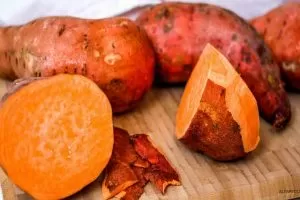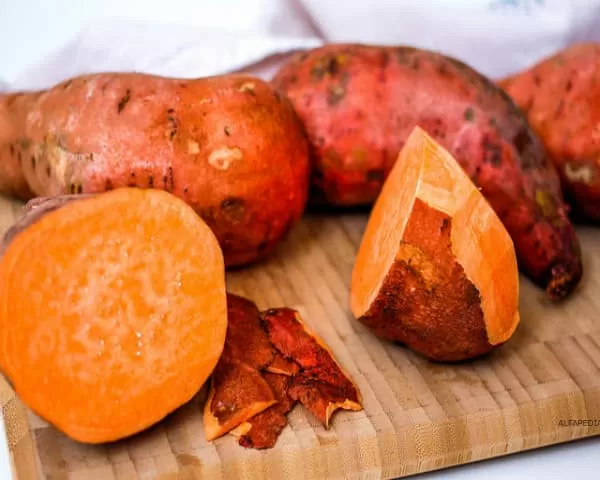Origin and History of the Sweet Potato
The sweet potato has a rich history and an interesting origin. It is one of the oldest vegetables known to mankind.
Scientists believe that the sweet potato was domesticated thousands of years ago in Central America. After his first trip to the Americas in 1492, Christopher Columbus brought the sweet potato to Europe. The crop was introduced to China in the late 16th century and spread to Asia, Africa and Latin America during the 17th and 18th centuries. It is hardy, has a wide adaptability and its planting material can multiply rapidly from very few roots. It is now grown in more developing countries than any other root crop.
The sweet potato has secondary centers of genetic diversity. These are geographical areas where the crop evolved separately from its American ancestors. In Papua New Guinea and other parts of Asia, many types of sweet potatoes can be found that are genetically different from those found in the Americas. It is not clear how the sweet potato got to the Southwest Pacific. Some researchers believe that European explorers took them there; others believe that the sweet potato was moved from one island to another in the Pacific by indigenous people.
Sweet potatoes are native to Central and South America. We have fossil evidence that sweet potatoes were growing in the Americas 35 million years ago. But very recently, scientists discovered 57 million year old fossil leaves in India that appear to be ancient morning glory leaves. This could surpass the U.S. claim as the point of origin of the sweet potato family by about 22 million years.
Properties of Sweet Potato
- Sweet potatoes are rich in fiber, vitamin C, potassium, pantothenic acid (vitamin B5), niacin (vitamin B3), vitamin B6, manganese, magnesium, and copper.
- They get their orange color from beta-carotene, which is a pigment and antioxidant. Sweet potatoes also contain a modest but useful amount of protein: about four grams per cup when cooked.
- Compared to white potatoes, sweet potatoes offer more vitamins and antioxidants. Surprisingly, considering their sweeter flavor, they also have a slightly lower glycemic index score. This makes them slower to digest.
- But the greatest nutritional glory of the sweet potato of all may be its rich supply of vitamin A. A single sweet potato provides more than twice the daily value of vitamin A.
Characteristics of Sweet Potato
- The sweet potato is widely grown in tropical and warm temperate climates and is an important food crop in the southern United States, tropical America and the Caribbean, the warmer Pacific islands, Japan and parts of Russia.
- The fleshy roots are served as cooked vegetables, whole or mashed, and used to fill cakes. In Japan, the crop has long been grown for drying and manufacturing starch and alcohol.
- Sweet potato stems are usually long and dragging and have lobed or unlobed leaves that vary in shape. The flowers, formed in clusters in the leaf axils, are funnel-shaped and dyed pink or purple.
- The edible part is the very large tuberous root, which varies in shape from fusiform to oblong or pointed oval. The colors of the root vary from white to orange and occasionally purple on the inside and light to brown or pink and red-purple on the outside.
- The pulp is mainly composed of starch, and the orange-fleshed varieties are rich in carotene. Propagated vegetatively by shoots emerging from the roots or by cuttings from vines, the plant is best adapted to light and friable soils, such as sandy loams. At least four to five months of warm weather are required to obtain large yields.
Benefits of Sweet Potato
- The consumption of fruits and vegetables of all kinds has long been associated with a reduced risk of many adverse health conditions.
- Research suggests that increasing consumption of plant foods, such as sweet potatoes, decreases the risk of obesity, diabetes, heart disease, and overall mortality.
- A diet that includes fresh fruits and vegetables can also promote a healthy complexion, increased energy and lower overall weight.
Below are some specific benefits of eating sweet potatoes:
Diabetes
Sweet potato is considered low on the glycemic index scale, and recent research suggests that it may reduce episodes of low blood sugar and insulin resistance in people with diabetes.
Fiber in sweet potatoes is also important. Studies have shown that people with type 1 diabetes who eat high-fiber diets have lower blood glucose levels, and people with type 2 diabetes have improved blood sugar, lipid, and insulin levels.
A medium-size sweet potato with skin on provides about 6 grams of fiber.
Blood Pressure
Maintaining a low sodium intake helps maintain healthy blood pressure. However, increasing potassium intake can be just as important.
According to the National Health and Nutrition Examination Survey, less than 2 percent of American adults meet the daily recommendation of 4,700 milligrams (mg) of potassium. A medium-size sweet potato provides approximately 542 mg.
High potassium intake is associated with a 20 percent decrease in the risk of death from all causes.
Cancer
According to a study conducted by the Department of Nutrition at the Harvard School of Public Health, among younger men, diets rich in beta-carotene may help protect against prostate cancer. Beta-carotene may also protect against colon cancer, according to a Japanese study.
Digestion and Regularity
Due to its high fiber content, sweetpotato helps prevent constipation and promotes regularity for a healthy digestive tract.
Fertility
For women of childbearing age, consuming more iron from plant sources appears to promote fertility, according to the Harvard Medical School’s Harvard health publications. Vitamin A in sweet potatoes (consumed as beta-carotene and then converted to vitamin A in the body) is also essential for hormone synthesis during pregnancy and breastfeeding.
Immunity
Vegetable foods such as sweet potatoes, which are rich in vitamin C and beta-carotene, offer increased immunity from their powerful combination of nutrients.
Inflammation
Choline, present in sweet potatoes, is a very important and versatile nutrient; it helps with sleep, muscle movement, learning and memory. Choline also helps maintain the structure of cell membranes, aids in the transmission of nerve impulses, aids in fat absorption and reduces chronic inflammation. In a study published in the Journal of Medicinal Food, purple sweetpotato extract was found to have anti-inflammatory effects and eliminate free radicals.
Vision
Vitamin A deficiency can damage vision; the cornea can dry out, which can cloud the front of the eye. It also prevents essential pigments from being produced. Correcting vitamin A deficiencies with foods rich in beta-carotene can restore vision.
It is also worth noting that the antioxidant vitamins C and E in sweet potatoes have been shown to support eye health and prevent degenerative damage.
Eating three or more servings of fruit per day has also been shown to decrease the risk and progression of age-related macular degeneration.
Nutritional Value of Sweet Potato
According to the USDA National Nutrient Database, a medium baked sweet potato with skin (2 inches in diameter, 5 inches long, approximately 114 grams) provides
- 103 calories
- 0 grams (g) of fat
- 24 g of carbohydrates, including 4 grams of fiber and 7 grams of sugar.
- 2.3 grams of protein
A medium-size sweet potato will provide more than 100 percent of your daily vitamin A needs as well:
- 25 percent of vitamin C
- 25 percent vitamin B6
- 12 percent potassium
You will also find small amounts of:
- Calcium
- Iron
- Magnesium
- Phosphorus
- Zinc
- Vitamin E
- Thiamine
- Riboflavin
- Folate
- Sweet potatoes are an excellent source of beta-carotene, a powerful antioxidant that gives orange fruits and vegetables their vibrant color. Beta-carotene is converted to vitamin A in the body.
Consumption of foods rich in beta-carotene can reduce the risk of developing certain types of cancer, offer protection against asthma and heart disease, and delay aging and body degeneration.
Keep your skin! The color of the skin of the sweet potato can vary from white to yellow and from purple to brown, but no matter what color it is, be sure not to peel it off. A sweet potato peel provides significant amounts of fiber, potassium, and quercetin.
Scientific Name of Sweet Potato
Sweet potato (Ipomoea batatas), food plant of the morning glory family Convolvulaceae.
Other Names for Sweet Potato
Depending on where the sweet potato comes from, it can be called sweet potato, kumara, camote or yam, to name a few.
White Sweet Potato
White potatoes: this is a generic term used to identify what is known as tropical sweet potatoes. Their meat is lighter in color than orange-fleshed sweet potatoes.
Although it all started with a North American plant, the sweet potato has adapted to many tropical regions around the world.
Purple Sweet Potato
- Purple sweet potatoes (sometimes mistakenly called purple sweet potatoes) are fun to cook with and can be used in many of the same ways as the more familiar orange or white sweet potatoes.
- Although some varieties have white skins, opening one of them will reveal its purple surprise. Popular in some Asian and Latino kitchens, they add a bright colorful touch to food and require only a few cooking adaptations.
- Purple sweet potatoes are tubers. The tubers are reduced to dots at both ends and are members of the genus Ipomoea, as are other sweet potatoes (yams are of the genus Dioscorea).
- There are two main varieties: Okinawa (white skin) and Stokes (purple skin), although they share the characteristic of having a dark purple flesh. The color comes from anthocyanins, the same pigment that gives color to cherries, strawberries, purple carrots and other vegetables.
- These sweet potatoes are easy to prepare and cook. They are not as easy to find as regular sweet potatoes and are more of a specialty item, so they will cost a little more.
Does the Sweet Potato Get Fatter ?
The answer is no, in fact they help you lose weight. Here are some reasons that make sweet potatoes the perfect food for weight loss:
- Sweet potatoes have fewer calories than potatoes. Therefore, having a medium-size sweet potato for snacks may not hurt your weight loss goals.
- Sweet potatoes are loaded with fiber, especially when served in their skins. Dietary fiber tends to absorb water, which makes you feel fuller and helps you follow a calorie-restricted diet.
- Regular potatoes are low in fiber content, which makes them less healthy than their counterparts.
- Sweet potatoes are known to reduce appetite. A study published in the Journal of Medicinal Food found that sweet potatoes have the ability to reduce fat cells.
- Sweet potatoes are rich in important nutrients, which can help you stay healthy as you lose weight.
- They are considered low-glycemic index foods that do not cause an instant increase in blood sugar levels, which helps maintain weight efficiently. Unstable blood glucose levels can cause conditions such as obesity and diabetes.
- The high water content in sweet potatoes makes them excellent for weight loss. Dehydration slows your metabolism, causing more weight gain and other health problems.
- Sweet potato consumption helps rehydrate cells and increase metabolic activity in the body. This, in turn, will help prevent your body from accumulating fat, balance natural pH levels and eliminate toxins.
Sweet Potato Recipes
There are millions of recipes with this easy to use, versatile and beneficial tuber, here are some basic and easy to make recipes.
Classic Sweet Potato Casserole
Ingredients
- 2 1/2 pounds sweet potatoes, peeled and cut into 1-inch cubes (6-8 medium sweet potatoes or ~ 8 cups chopped)
- 1/2 cup of cold water
- 3/4 cup light brown sugar, packed
- 4 tablespoons unsalted butter (half a stick or 1/4 cup), softened (sub by vegan butter to make no dairy)
- 1 teaspoon vanilla extract
- 1 teaspoon of ground cinnamon, or more to taste
- 1/4 teaspoon nutmeg pinch of salt
- 1/2 cup of nuts (or walnuts), chopped, divided (optional, omit if allergic to nuts or use only marshmallows)
- 2 cups of mini marshmallows, optional (or sub for vegan marshmallows)
Instructions
- Preheat oven to 375 degrees F. Spray a pan or deep baking dish with cooking spray. Set aside.
- Place the sweet potatoes in a pan of cold water. (I PROMISE that 1/2 cup of cold water is enough to steam the sweet potatoes. There is no need to cover all the sweet potatoes with water. TRUST ME).
- Bring to a boil, then cover and reduce heat. The sweet potatoes will become tender with the steam. Simmer for 15-25 minutes or until the potatoes are tender enough to mash. Drain. Allow to cool slightly.
- Transfer sweet potatoes to a large bowl. Mix sweet potato mixture with a potato masher. Add brown sugar, butter, vanilla extract, cinnamon, nutmeg, salt and 1/4 cup of nuts (save the rest for later). Stir until well combined.
- Add the sweet potato mixture evenly to the pan. Top with remaining pecans and mini marshmallows. ** Bake for 15 minutes or until marshmallows are toasted. Remove from oven. Serve and enjoy!
Notes:
- You can prepare the sweet potato mixture 1 day in advance, place it in an oven dish, cover the top with aluminum foil and then refrigerate until the next day.
- Before serving, bring sweet potato mixture to room temperature, cover with nuts/marshmallows and then place in the oven to bake for 15-20 minutes at 375 degrees F.
- Grated sweet potatoes are an excellent alternative to the high calorie pie crust in this spinach, bacon and cheese quiche with a sweet potato crust, adding a touch of sweetness to this tasty and hearty quiche!
Spinach, Bacon and Cheese Quiche with Sweet Potato Rind
Ingredients
- Sweet potato crust
- 3 1/2 cups of grated sweet potatoes
- 1 egg white
- 1 tablespoon flour (use gluten-free flour or cornstarch if necessary)
- 2 teaspoons of olive oil
- 3/4 teaspoon kosher salt
- 1/4 teaspoon freshly ground black pepper
Quiche filling:
- 4 slices of bacon
- 2 green onions, thinly sliced
- 2 1/2 cups of baby spinach
- 4 eggs
- 3 egg whites
- 3/4 cup low-fat milk
- 3/4 cup grated gruyere or Swiss cheese
- 1/2 cup of chopped cheddar cheese
- Kosher salt and freshly ground black pepper to taste
Instructions
Sweet Potato Rind
- Preheat the oven to 425 degrees and spray a 9-inch cast iron or other ovenproof skillet with cooking oil.
- Place the grated sweet potatoes in a bowl of water and stir to release some starch.
- Drain and place the sweet potatoes on a clean towel and squeeze out excess liquid.
- Place the sweet potatoes back in the bowl, add the oil, egg white, flour, salt and pepper and stir to coat.
- Pour sweet potato mixture into prepared pan and press in an even layer along the bottom and sides.
- Bake for 20-25 minutes or until golden brown.
- Remove from oven and add quiche filling.
- Lower oven temperature to 375 degrees.
- Heat a 9-inch cast iron or other ovenproof skillet over medium heat.
- Use kitchen shears or a knife to cut the bacon into small pieces and add them to the hot pan.
- Cook the bacon until it is crisp and then drain it on a plate lined with paper towels.
- Remove excess fat from pan, but do not clean it.
- Add the green onions and spinach to the pan and sauté until the spinach wilts.
- Remove the spinach and onions from the pan and place them on the plate with the bacon.
- Once the spinach has cooled enough to handle, squeeze out excess liquid.
- In a large bowl, mix all the filling ingredients and set aside 1/4 cup of the grated cheeses.
- Pour the filling into the baked sweet potato crust and top with the remaining 1/4 cup cheese.
- Place quiche in oven and bake for 35-40 minutes or until filling is ready and top is golden brown.
- Remove from oven and let stand for 5-10 minutes before serving.
Sweet Potato Cake Bars
Description:
These sweet potato pie bars are gluten-free, vegan, and made with only 9 healthy ingredients! Perfectly seasoned, refined sugar-free and oil-free.
Ingredients:
For the filling:
- 4 cups sweet potato, peeled and diced (about 2 medium)
- ½ cup sugar-free non-dairy milk (I used soy)
- ½ cup maple syrup
- 3 tablespoons arrowroot powder ?
- 1 tablespoon of pumpkin pie spices
- 1 teaspoon vanilla extract
- Pinch of salt
For the Bark:
- 1 cup of nuts
- 1 cup rolled oats
- 2 tablespoons of flax + 5 tablespoons of filtered water
- 3/4 teaspoon salt
Instructions
- Preheat the oven to 350F. Add the diced sweet potatoes to a vegetable steamer or a pot + strainer combination with 3 ″ water. Cover and steam for 15 minutes, or until fork is tender.
- Meanwhile, prepare the base layer for the bars. Mix 2 tablespoons of ground flaxseed with 5 tablespoons of filtered water in a small bowl and set aside to thicken. Add the pecans, rolled oats, and salt to a food processor and process until a fine crumb forms.
- Once the flax egg has thickened, add it to the pecan and oat mixture and pulse until well combined; the mixture should form a sticky “mass
- Press the dough into a greased or lined 9 × 9 baking pan ″; I like to use a spatula to make sure it’s really compact and even. Quickly rinse the food processor and then return it to its base.
- Steam the sweet potato in the food processor with the remaining ingredients and process until thick and smooth. Spread this mixture over the top of the pecan and oat crumble, using a spatula again to level the top.
- Place baking pan in oven and bake for 30-35 minutes; cool for at least 30 minutes before removing from pan and slicing. Cover as desired, a good option is to serve with some coconut shavings and a Pecan.
How to Cook the Sweet Potato ?
Here are some suggestions on how to cook the sweet potato:
Baked Sweet Potato
A simple baked sweet potato is the best comfort food. Simply preheat the oven to 400 F, prick the potato with a fork, wrap it in aluminum foil and place it in the oven for 40 to 60 minutes, until it softens to your liking. When finished, open it and fill it with your favorite ingredients.
Spicy Sweet Potato Kabobs
Add this recipe to your line of summer kebabs. Make it simple with sweet potatoes and pearl onions, or mix it up and add your favorite vegetables. Combine them with some homemade tahini sauce and you have an A+ application.
Sweet potato “baked” in the microwave
- Would you like a baked tater, but don’t have time to roast it slowly in the oven? Your microwave can reduce the time.
- Simply wash your sweet potato, pierce everything with a fork and place it in the microwave on a damp paper towel. (You can place the towel on a plate or directly on the microwave tray.)
- Microwave on high for about four minutes, then check your potato for firmness. Continue microwaving at one-minute intervals, until it softens to your liking.
Sweet Potato Stew
Marshmallows for dinner; Need we say more? This recipe reduces the sugar used in most sweet potato casseroles to give it a twist that is not only a little healthier, but actually allows the natural flavors to shine through.
Sweet Potato Chips
For a tasty snack, fry a batch of sweet potato slices. All you have to do is cut your stash and cook them in a pan until they are crisp. They are like thick, sweet chips!
Sweet Whole Wheat Potato Crowns
If the sweet potato pie and cinnamon rolls had a baby, it would be this recipe. The homemade dough is filled with sweet potato puree and covered with a cinnamon and walnut streudel.
Fried Sweet Potatoes
Spiced Sweet Potato Chips
These crunchy baked sweet potato chips will satisfy your cravings for a fraction of the calories and fat. Baking the fries, instead of frying them, is much healthier and just as tasty. We throw the sweet potatoes in with a cumin and cilantro seasoning to give them flavor, then finish with fresh cilantro and lime.
Don’t skip the cornstarch, as it absorbs moisture when the potatoes are baked and helps them get crunchy. And don’t try to put all the fries on a baking sheet. If you put too many in the pan, they will simply vaporize each other and you will end up with soggy fries. Serve these fries in the oven with an avocado burger or as an accompaniment to black bean and cheese quesadillas.
Ingredients
- 4 sweet potatoes
- 2 tablespoons of cornstarch
- 1 teaspoon of ground cumin
- 1/2 teaspoon of ground coriander
- 1/2 teaspoon kosher salt
- 1/4 teaspoon black pepper
- 1 tablespoon of canola oil
- 1/4 cup chopped cilantro
- Lime chips
How to do it ?
Preheat the oven to 450 ° F. Cut the sweet potatoes into 1/4 inch thick chips. Combine with cornstarch, ground cumin, ground coriander, kosher salt and black pepper in an airtight plastic bag; seal the bag and twist to cover.
Spread in an even layer on 2 rimmed baking trays; spray each with canola oil and toss to coat. Bake for 22 to 25 minutes, stirring 3 times. Sprinkle with chopped cilantro. Serve with lime slices.
Baked Sweet Potatoes
A baked sweet potato is the easy and perfect side for roasting chicken or pork, but it can also stand alone as a vegetarian main dish.
Buy long, thin sweet potatoes, as this form will cook faster and more evenly. You’ll also want to use a hot oven, at least 400 degrees or more, to make sure the skin is crisp.
Be sure to prick the potato skin in several places with a fork so that steam can escape while cooking.
Simply brush with a little olive oil, salt and pepper, and place in an aluminum foil-lined baking dish. Bake until the skin is crisp and the insides are tender. Depending on your oven and the size of your potato, this takes about 45 minutes to an hour.
Once your sweet potatoes are baked, you can stuff them with all kinds of delicious ingredients.
Stay sweet with a little butter and a pinch of brown sugar, or taste the feta cheese, crumbled bacon, sour cream, fresh chives or even the homemade roast pork.
How to Plant the Sweet Potato ?
- The best soil for sweet potatoes is sandy, but they can grow in all soils. If you have heavy soil, plant sweet potatoes on mounds or ridges.
- Raising the beds improves drainage (very important) and gives the tubers deep, pleasant soil to grow in. (Otherwise, you may end up with small, bent, forked sweet potatoes.)
- The soil must have a good supply of nutrients, for example, when digging in mature compost. Do not use fresh manure or high nitrogen fertilizers (such as granulated chicken manure). You would end up with many leaves and no tubers.
- Growing sweet potatoes requires some space, so plant them where they can spread. Space your cuttings or slips about a foot apart in a row, and leave three to four feet between rows.
Mulch between plants and even between beds to keep the weeds down. Once the sweet potatoes grow, they will choke out all the weeds. - For planting time, the general recommendation is to plant a patch in the spring. (May in the northern hemisphere, November in the south). In a cool climate, you may have to survive with only one planting. Sweet potatoes need four to six months of reasonably warm weather to mature.
- But in the tropics a large spring planting doesn’t make sense unless you’re a commercial grower.
- Sweet potatoes don’t keep well after harvest, so the best way is to plant a few cuttings every week or two. Just a one meter long row of three cuttings. They will take 16 to 18 weeks to mature in warm climates, longer in colder climates.
- That way, you can grow sweet potatoes all year round, and you won’t run into a big pile of them all at once.
How to Make Sweet Potato Candy ?
There are many options when it comes to sweet potato candy, here is a simple and easy recipe:
- Servings: 18
- Preparation time: 15 min.
- Cooking time: 20 min.
What you need:
- 2 c. light brown sugar
- 3/4 c. evaporated milk
- 1 tablespoon. butter or margarine
- 1/8 teaspoon salt
- 1 c. cooked and mashed sweet potatoes
- 1/2 c. chopped nuts
What to do:
Put sugar, milk, butter and salt in a large pot. Cook over medium heat until soft ball stage.
Remove from heat and let cool until hand can be comfortably held at the bottom of the pot. Add the sweet potatoes and beat until the mixture loses its shine. Add the nuts, mix well and pour into a pan with butter. Cut into squares when cold.
How to Make Sweet Potatoes with Cheese ?
- Sweet potatoes with garlic and cheese are the perfect side dish or appetizer! Mozzarella and Parmesan cheese top these tender sweet potatoes roasted with garlic butter!
- Sweet potatoes with garlic and cheese
Ingredients
- 4 small or medium sweet potatoes, half lengthwise (ends trimmed)
- 1/4 cup melted garlic butter
- Sea salt to taste
- Black pepper to taste
- 3/4 cup grated mozzarella cheese
- 1/2 cup grated fresh Parmesan cheese
- 2 tablespoons of fresh or dried chopped parsley
Instructions
Heat the oven to 220 ° C | 425 ° F. Spread the potatoes with garlic butter and season each potato with salt and pepper. Arrange the cut side down in a lightly greased baking dish until golden and the meat is tender (approximately 20-30 minutes, depending on your oven).
Take them out of the oven, turn them over with the cut side up (skin side down) and cover with the mozzarella, parmesan and parsley.
Change oven settings to medium or low heat and roast until cheese is golden and melted (about 2 minutes). Sprinkle with more salt and pepper, if desired. Serve warm.
Nutrition
Calories: 162kcal | Carbohydrates: 13g | Protein: 5g | Fat: 9g | Saturated Fat: 6g | Cholesterol: 27mg | Sodium: 252mg | Potassium: 232mg | Fiber: 1g | Sugar: 2g | Vitamin A: 9520 IU | Vitamin C: 1.6mg | Calcium: 148mg | Iron: 0.5mg
How to Make Sweet Potato with Chicken ?
Here is a simple recipe, but a delicious combination:
Roast chicken and sweet potatoes
Ingredients
- 1 small sweet potato, diced
- 1 lemon, sliced, seeded
- 1 cup of green beans (360 g), cut
- 1 tablespoon of olive oil
- 1 tablespoon fresh rosemary, chopped
- 1 tablespoon of fresh thyme, chopped
- 1 garlic clove, minced
- ½ teaspoon salt, plus more for seasoning
- ¼ teaspoon ground black pepper, plus more for seasoning
- 1 boneless, skinless chicken breast
- ¼ teaspoon of paprika
Preparation
- Preheat the oven at 375˚F (190˚C).
- Add the sweet potatoes, lemon slices, green beans, olive oil, rosemary, thyme, garlic, salt and pepper in a large bowl (or a parchment lined sheet tray) and stir until completely covered.
- Season the chicken breast with salt, pepper and paprika.
- Transfer to a tray of parchment lined sheets and place the chicken breast on top of the vegetables (if you threw the vegetables in a bowl).
- Bake until vegetables are tender and chicken is cooked through, about 20 minutes.
- Enjoy!
How to Make Sweet Potato with Cinnamon and Sugar ?
Wonderful slices of sweet potato baked slightly sweet. The amounts of ingredients are only a suggestion. I always have a mixture of cinnamon and sugar on hand.
Sweet Potato Slices with Cinnamon
Ingredients
- 4 medium sweet potatoes, peeled and sliced
- 1/2 inch thick 1/4 cup melted butter
- 2 tablespoons of sugar
- 1/2 teaspoon ground cinnamon
Indications
- Preheat the oven to 350 degrees F (175 degrees C). Spray a baking sheet with cooking spray.
- Place the sweet potato slices on the baking sheet. Brush with half the butter. Mix the sugar and cinnamon in a small bowl and sprinkle 1/2 over the potatoes.
- Bake for 15 minutes in the preheated oven. Turn, brush with remaining butter and sprinkle with remaining cinnamon and sugar. Continue baking for 15 minutes or until tender.
Nutrition Facts: Per serving: 322 calories; 11.6 g fat; 52.2 g carbohydrate; 3.7 g protein; 31 mg cholesterol; 207 mg sodium.
How to make Sweet Potato with Chickpeas ?
A simple and delicious recipe of sweet potato and chickpeas.
Ingredients
- 2 large, or 3 small, scrubbed sweet potatoes
- ½ medium red onion
- 15 oz chickpeas (425 g), 1 can, rinsed and drained
- ½ cup of olive oil (120 ml)
- ¼ cup lemon juice (60 ml)
- 2 tablespoons of chopped garlic
- 1 teaspoon of ground cumin
- 1 teaspoon of paprika
- ¼ teaspoon cinnamon
- ¼ teaspoon of cayenne pepper
- Salt to taste
- Pepper to taste
- 3 oz of mixed vegetables (85 g)
- ¼ cup fresh parsley (10 g), chopped
- ¼ cup fresh cilantro (10 g), chopped
- Dried cranberry, for decoration, optional
Preparation
- Preheat the oven to 425ºF (220ºC).
- Cut the sweet potatoes into small cubes and transfer them to the middle of a non-stick baking sheet.
- Peel and slice the onion and set aside.
- Add the chickpeas to the other half of the baking sheet.
- In a liquid measuring cup with a nozzle, combine olive oil, lemon juice, garlic, cumin, paprika, cinnamon, pepper, salt and pepper and mix well.
- Pour half of the dressing over the sweet potatoes and chickpeas and mix with your hands until well covered. Keep chickpeas and sweet potatoes separated as much as possible.
- Transfer the chickpeas to the sweet potatoes and add the onions to the baking dish. Make sure everything is evenly distributed.
- Bake for 30 minutes, until the potatoes are tender. Use tongs to stir in half. Let cool for 20 minutes.
- Place the vegetables in a large bowl. Top with roasted chickpeas, sweet potatoes, and onion.
- Add remaining parsley, cilantro and dressing and stir to combine.
- Top with dried cranberries, if using.
Enjoy!
How to Plant or Sow the Sweet Potato ?
- Sweet potatoes will grow in poor soil, but the deformed roots may develop into heavy clay or long, fibrous roots in sandy soil. To create the perfect environment, create long, wide, 10-inch high ridges spaced at 3½ feet apart. (A 10-foot row will produce 8 to 10 pounds of potatoes.)
- Work with abundant compost, avoiding nitrogen-rich fertilizers that produce lush vines and stunted pipes. In the north, cover raised rows with black plastic to keep the soil warm and promote strong growth.
- It is best to plant root crops, called slips, available from nurseries and mail order suppliers. (Store-bought sweet potatoes are often waxed to prevent sprouting.) ) Save some roots from your crop to plant next year.
- About six weeks before it’s time to plant sweet potatoes outdoors in your area, place the roots in a wet sandbox, sawdust or chopped leaves in a warm (75 to 80 degrees) place.
- They will sprout, and when they reach 6 to 9 inches long, cut them off from the root. Remove and discard the bottom inch of each slide, as that portion sometimes harbors pathogenic organisms.
- Sweet potatoes mature in 90 to 170 days and are extremely sensitive to frost. Plant in full sun three to four weeks after the last frost when the soil has warmed up.
- Make holes 6 inches deep and 12 inches apart. Slide into the top leaves, press the soil gently but firmly, and water well.
- If you are not using black plastic, cover the vines two weeks after planting to smother weeds, conserve moisture, and keep the soil loose for root development.
- Occasionally, raise longer vines to prevent them from rooting in the joints, or they will put their energy into forming many smaller tubers in each rooted area instead of ripening the main crop at the base of the plant.
- Otherwise, handle the plants as little as possible to prevent injury from vulnerable disease spores.
- If the weather is dry, provide 1 inch of water per week up to two weeks before harvest, then allow the soil to dry out slightly. Don’t overwater, or the plants, which can withstand dry periods better than rainy ones, may rot.
- Protection against pests
- Sweet potato weevils (¼ inch long insects with dark blue heads and wings and orange-red bodies) pierce stems and tubers to lay their eggs.
- The developing larvae tunnel and feed on the fleshy roots, while the adults usually attack the vines and leaves. They also spread foot rot, which creates increasingly large brown to black areas on stems near the ground and at stem ends.
- Because weevils multiply rapidly and are difficult to eliminate, use certified disease-resistant slips and practice a four-year crop rotation.
Destroy infected plants and their roots, or place them in sealed containers and dispose of them with household waste.
How to Identify Common Plant Diseases
- Fungal diseases include black rot, which produces dark circular depressions in the tubers. Discard infected potatoes and carefully treat undamaged roots from the same crop.
- Do not confuse this disease with a less severe loofah, which creates small, round, dark spots on the tuber surfaces, but does not affect the quality of the food.
- Stem rot or wilt is a fungus that enters plants damaged by insects, neglected crops or wind. Even if this disease does not kill the plants, the harvest will be poor.
- Minimize the chances of disease by planting only healthy pieces; avoid black and stem rot by planting resistant cultivars. Reduce the incidence of dry rot, which mummifies stored potatoes, by keeping the roots fleshy at 55 to 60 degrees.
- You can harvest as soon as the leaves begin to turn yellow, but the longer a crop stays in the ground, the higher the yield and the higher the vitamin content. However, once the frost blackens the vines, the tubers can quickly rot.
- Use a fork to dig up tubers on a sunny day when the soil is dry. Remember that tubers can grow a foot or more from the plant, and any tearing of their tender skins will encourage deterioration.
- Dry the tubers in the sun for several hours, then move them to a well ventilated place and keep them at 85 to 90 degrees for 10 to 15 days.
- After they are cured, store them at about 55 degrees, with a humidity of 75 to 80%. Cured and properly stored sweet potatoes will keep for several months.
Related Topics in ALPHAPEDIA
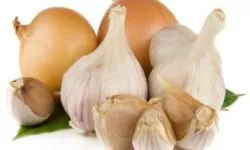
GARLIC: Properties, Benefits and Contraindications
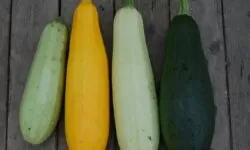
ZUCCHINI: Properties, Benefits and Characteristics

CELERY: Properties, Benefits and Contraindications
Health and Wellness Issues at ALPHAPEDIA
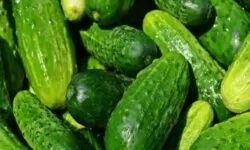
CUCUMBER: Fruit or Vegetable. Benefits and Properties
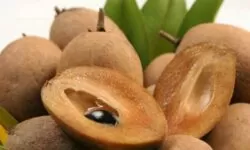
LOQUAT: Properties and Benefis. What Is It For ?

BLUEBERRIES: Benefits, Properties and Contraindications

GARLIC: Properties, Benefits and Contraindications

BANANA: Benefits, Properties and Contraindications

APRICOT: Properties, Benefits and Their Contraindications
Other Topics of Interest in ALPHAPEDIA

FREE MASTER DEGREE IN ECOLOGY

FREE BARISTA COURSE

FREE FLIGHT ATTENDANT OR GROUND STEWARDESS COURSE

FREE FLOWER ARRANGEMENT COURSE

SUGAR CANE: Properties, Benefits and Risks

FREE ENTREPRENEURSHIP COURSE
SWEET POTATO IMAGE
